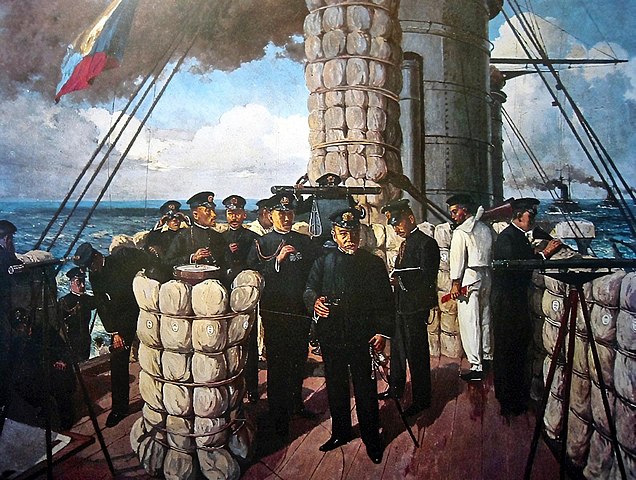
T?j? Sh?tar? (1865–1929)
Public Domain-US/Wikimedia Commons
On 27 May 1905, the Russian Baltic fleet engaged the Japanese navy at Tsushima Strait, which lies between Korea and Japan. The battle was a decisive win for the Japanese with the Russians losing 34 ships. It shifted the balance of power in Asia for years to come.
Background
The Russia-Japan War of 1904-1905 was the first major war of the 20th century. Russia was large territorially but due to harsh winters needed a warm water port for its navy to operate. They expanded into both China and Korea to acquire resources and establish a naval base at Port Arthur ( Lüshunkou District today) in Liaodong Peninsula in China. Japan was not happy with Russia expanding into these areas and that it had supported the Chinese during the 1894 conflict. Japan tried to work out a deal to allow Russia access to Korea under Japanese control. The Russians did not agree, and Japan decided to attack Russia. Since international law at the time did not require a declaration of war prior to an attack, they delivered notice on the very day of the attack to the Russians.
Japan had quickly modernized and westernized once it opened for trade. The arrival of Commodore Perry in 1853 put pressure on Japan to open to the world. It was still ruled by Tokugawa shogunate (military rule) which had begun in the 1600’s. Foreigners were not allowed though a Dutch trading post was allowed owing to special connection created by William Adams. He was an English navigator for Dutch fleet that sailed to Japan. Williams became an advisor to the shogun Tokugawa Ieyasu and stayed in Japan for the remainder of his life. He was the basis for the fictional John Blackthorne in the novel Shogun. He did become samurai, a rare honor for a foreigner and Hatamoto.
By the mid-19th century though the shogunate was showing its age. While it controlled contact with foreigners, many had been exposed to Western technology and ideas. Internally things were starting to come apart. A series of famines led to unrest and the belief the shogunate was unable to cope. Also, the fact they were bullied by other nations (particularly the United States) to open their borders for trade led to the fall of the shogunate in 1867. This led to a period called the Meji Restoration where power was restored to the throne. It brought about an end to the feudal system and a cabinet style of government. Trade with the west ramped up along with the desire to create a military that would not only defend them but make them a power as well.
The surprise attack on 8 February 1904 shocked the world. The Russian military did not believe Japan would attack, and if it did would be easily repelled. Under the command of Admiral Togo Heihachiro, the Japanese fleet sank ships and bombarded the city. While Russian ships further in the bay were protected, the Japanese bombarded the city and attempted to blockade (this proved difficult). However, the Japanese did not give up and ultimately kept pounding the city for months preventing any military aid (from land or sea) to aid the Russians. The city would surrender formally in January 1905 when General Anatoly Stessel surrendered to the Japanese seeing it was no longer worth defending (it surprised his superiors in St. Petersburg). His surrender was controversial as he still had large stores of ammunition available to him. He would be court martialed later for cowardice and sentenced to death (later changed to 10 years imprisonment). He would be pardoned later by Czar Nicholas II.
Believing the Russian navy could still defeat the Japanese, the Czar created the Third Pacific Fleet and joining with the Second Fleet would become the Baltic Fleet that would sail 18,000 miles from Kronstadt (St. Petersburg) to meet the Japanese at Tsushima Strait. Admiral Togo had plenty of time to prepare to meet the Baltic fleet. Togo had already wiped out the Russian fleet at Port Arthur. A naval squadron from Vladivostok had proven its effectiveness by sinking Japanese transports. However, in August 1904 a confrontation with Japanese forces resulted in the sinking of one heavy armored cruiser. The other two ships had been severely damaged and had to return to port unable to fight again for a long while. During the interim, Togo sent many of his ships back to their home ports for repairs. And he spent time training the crews for the upcoming battle.
This meant the Russians were facing well rested and trained crews, along with ships that had been repaired and ready for battle. Togo’s plan was to trap the Baltic fleet in the Tsushima Strait and to engage them in several operations. On the Russian side, Admiral Rojestvensky and his staff argued on the best course to attack the Japanese. Ultimately, he decided on Tsushima on May 17 and ordered the fleet to proceed. Togo had built watchtowers all over the area and manned to watch for the Russian arrival. Over 70 ships, many converted commercials vessels, were sent out to watch and report of any Russian movement. Early on the morning of 27 May, confirmation was finally made of the Russian fleet and that it was headed for Tsushima Strait.
The battle would last for two days and was decisive. Of the 38 Russian ships that were in battle, 34 were sunk or captured (some were interned in neutral ports). One transport and two destroyers managed to get to Vladivostok; one cruiser managed to get all the way back to Kronstadt. Togo lost three torpedo boats, but the Russian Pacific fleet had been destroyed. It is considered one of the greatest naval victories in modern history.
Aftermath
The destruction of the Russian Baltic Fleet astonished and shocked Europe and America. Japan now was a major force in Asia to be reckoned with. President Theodore Roosevelt of the United States negotiated a peace treaty between the two in August 1905 (Treaty of Portsmouth). The balance of power in Asia was a central issue since the war involved (directly and indirectly) China, Korea, Europe, and the United States. Russia would give up its claims in Korea and China and recognize Japan as the dominant power in Korea. The colonial powers in Asia were now on notice. Japan was now in the game, and you ignore it at your peril.
Anti-Japanese sentiments would grow because of the war. In California, the Alien Land Act was passed in 1913. This law prohibited the ownership or leasing of land by those banned from citizenship under federal law. Many Japanese immigrants had bought agricultural land to raise crops, so the law was to target them (it also effected Chinese and others as well). To get around it, many Japanese put their American born male children as owners. Such laws were common in many Western states. And legislatures enacted restrictions on that later as well. The U.S. Supreme Court declared such laws constitutional and would remain in force until the 1950’s. Then they were either rescinded or made invalid when the Supreme Court ruled that they were unconstitutional (Oyama v, California (1948) and Fuji Sei v. State of California (1952). During the time they were in place, many Japanese Americans were forced to give up their farms and relocate elsewhere.
Russian prestige was hit hard by the disastrous military defeat. Other powers (Britain, France, Germany and to a lesser extent the United States), no longer viewed Russia as a strong military power. Russia was already considered a backward country where much of its population was agrarian with a thin industrial strata of industrial workers. They had serfdom-where landless peasants were forced to serve nobility who owned lands-until 1861. The large cities by 1900 had become overcrowded with industrial workers who were not paid very much. A combination of costly wars starting in the last century, periods of famine, and general resentment against the monarchy all contributed to the Russian Revolution of 1905. While the Czar did implement reforms to placate the populace, the entry of Russia into World War I in 1914 resulted in even more unrest due to food shortages, ruined economy, and military defeats. The Communists would ultimately topple the regime in 1918.
Sources:
The Battle of Tsushima, 1905 (Naval Historical Society of Australia)
History.com
Immigrationhistory.org
Portsmouthpeacetreaty.org

